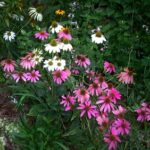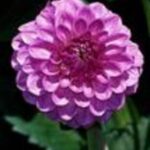I love flowers and have many, many favorites, so if you ask me what my favorite flower is, my answer may be different each time you ask. Today, I want to talk about zinnias; they are one of my favorite annuals. It can reseed itself or you can harvest the seeds once the flower fades and dries. I’m real found of perennials and annuals that reseed themselves, not that I’m lazy or anything, but it really makes my heart grow fonder when a flower can take care of its own yearly return to my garden. Zinnias come in several bright colors; in fact I think they come in every color but blue and black. Who knows someday in the future that may change.
Zinnias bloom from summer to fall here in the South. If you are a beginner gardener looking for something easy to grow these beautiful flowers are for you.
Zinnias come in a variety of sizes from 6 inches to 36 inches. Most of the zinnias in my yard are between two and three feet tall and are a little bit bushy. To see a short movie of some of the zinnias in my yard click here. I love all the zinnias in my gardens, but this year we planted a new to us variety of zinnias called peppermint stick and they have become my favorite of all the zinnias we have. The blooms of the peppermint stick zinnias have either yellow and red stripes or white and red or orange and red stripes; they are gorgeous.
Name origin:
The flower is named after a Johann Gottfried Zinn (1737-1759), a professor of Botany at Gottingen University in 18th century. His name was used because he was the first person to publish a scientific drawing of the plant in 1753.
Scientific Name
Genus: Zinnia L.
Family: Asteraceae
History
The original zinnias came from Mexico where they were considered so ugly that the Spanish called the flower “eyesores.” In the 16th century Spanish explorers brought “eyesores” seeds back to Europe, where the flower was considered so ugly that no one wanted it. In case you are wondering, the original zinnias were a small weedy looking wildflower that had a dull purple bloom. Botanists worked hard for many years to cultivate a beautiful looking flower from these seeds and by the 18th century, zinnias were so popular that they were commonly found in Victorian gardens.
Medicinal Purposes:
Zinnias have no medicinal purpose.
Meaning In the Language of Flowers:
Bright red zinnias: Constancy
Magenta zinnias: Lasting affection
Mixed zinnias: In memory of or a remembrance of an absent friend
Yellow zinnias: Daily remembrance
White zinnias: Goodness
Planting Instructions:
Plant the seeds in full sun with some afternoon shade if you are in the Deep South, otherwise full sun all day would be good. Be sure to just barely cover them with dirt. It takes about a week to three weeks for the seeds to germinate depending on the weather and how soon the zinnias want to join us.
Wait until after the last frost in the spring to sow the seeds outdoors. If you start the seeds indoors then transplant them when both the danger of frost is gone and when the plant is at least 3 inches tall. If you don’t plan on harvesting the seeds, deadhead (cut off the old blooms) the faded blooms. If you harvest the seeds be sure to spread them out to dry before storing them for the winter.
References:
Foster, Steven and Christopher Hobbs. A Field Guide to Western Medicinal Plants and Herbs. New York: Houghton Mifflin Company, 2002.
Healey, B. J. A Gardener’s Guide to Plant Names. New York: Charles Scribner’s Sons, 1972.
Hill, Lewis and Nancy. The Flower Gardener’s Bible. North Adams, MA: Storey Books, 2003.
Powell, Eileen. The Gardener’s A-Z Guide to Growing from Seed to Bloom. North Adams, MA: Storey Books, 2004.
http://plantanswers.tamu.edu/publications/flowers/flowers.html. Visited 12-6-2007.






